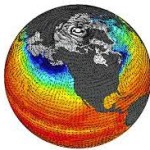“There are large efforts towards refining the horizontal resolution of climate models to O(1 km) with the intent to represent convective clouds explicitly rather than using semi-empirical parameterizations. This refinement would move the governing equations closer to first principles and is expected to reduce the uncertainties of climate models. However, the output volume of climate simulations would dramatically grow, and storing it for later analysis would likely become impractical, due to limited I/O bandwidth and mass-storage capacity. In this presentation we discuss possible solutions to this challenge.”
Evolving Storage and Cyber Infrastructure at the NASA Center for Climate Simulation
Ellen Salmon from NASA gave this talk at the 2017 MSST conference. “This talk will describe recent developments at the NASA Center for Climate Simulation, which is funded by NASA’s Science Mission Directorate, and supports the specialized data storage and computational needs of weather, ocean, and climate researchers, as well as astrophysicists, heliophysicists, and planetary scientists.”
Video: Tracing Ocean Salinity for Global Climate Models
In this visualization, ocean temperatures and salinity are tracked over the course of a year. Based on data from global climate models, these visualizations aid our understanding of the physical processes that create the Earth’s climate, and inform predictions about future changes in climate. “The water’s saltiness, or salinity, plays a significant role in this ocean heat engine, Harrison said. Salt makes the water denser, helping it to sink. As the atmosphere warms due to global climate change, melting ice sheets have the potential to release tremendous amounts of fresh water into the oceans.”
SGI Opens European Research Centre at ICHEC in Ireland
Today SGI announced a significant investment in extreme scale software research at the Irish Centre for High-End Computing (ICHEC), a top European center. The investment highlights the commitment of SGI to the European software research community. These resources, including SGI application software and supercomputing hardware expertise, will assist scientists as they explore issues related to climate change, weather forecasting, and environmental research among many other topics.
Video: A NASA Perspective on El Niño
In this video, Steven Pawson discussed how NASA uses computer models to build up a complete three-dimensional picture of El Niño in the ocean and atmosphere. Pawson is an atmospheric scientist and the chief of the Global Modeling and Assimilation Office at NASA’s Goddard Space Flight Center in Greenbelt, Maryland.
Challenges for Climate and Weather Prediction in the Era of Heterogeneous Architectures
Beth Wingate from the University of Exeter presented this talk at the PASC16 conference in Switzerland. “For weather or climate models to achieve exascale performance on next-generation heterogeneous computer architectures they will be required to exploit on the order of million- or billion-way parallelism. This degree of parallelism far exceeds anything possible in today’s models even though they are highly optimized. In this talk I will discuss the mathematical issue that leads to the limitations in space- and time-parallelism for climate and weather prediction models – oscillatory stiffness in the PDE.”
Video: Climate Change, Chaos, and Inexact Computing
In this video from the Perimeter Institute for Theoretical Physics in Ontario, Dr. Tim Palmer from the University of Oxford presents: Climate Change, Chaos, and Inexact Computing. “How well can we predict the climate future? This question is at the heart of Tim Palmer’s research into the links between chaos theory and the science of climate change. Palmer will discuss climate modeling, the emerging concept of inexact supercomputing, and chaos theory.”
Supercomputing Extreme Weather Events and Climate Change
A recent study conducted by the Barcelona Supercomputer Center suggests that calibrated model ensembles improve the trustworthiness of climate event attribution to extreme weather events. The study also found that current climate model limitations tend to overestimate climate change attribution.
How HPC is Helping Solve Climate and Weather Forecasting Challenges
Data accumulation is just one of the challenges facing today weather and climatology researchers and scientists. To understand and predict Earth’s weather and climate, they rely on increasingly complex computer models and simulations based on a constantly growing body of data from around the globe. “It turns out that in today’s HPC technology, the moving of data in and out of the processing units is more demanding in time than the computations performed. To be effective, systems working with weather forecasting and climate modeling require high memory bandwidth and fast interconnect across the system, as well as a robust parallel file system.”
HPC Helps Drive Climate Change Modeling
Because of the complexity involved, the length of the simulation period, and the amounts of data generated, weather prediction and climate modeling on a global basis requires some of the most powerful computers in the world. The models incorporate topography, winds, temperatures, radiation, gas emission, cloud forming, land and sea ice, vegetation, and more. However, although weather prediction and climate modeling make use of a common numerical methods, the items they compute differ.












